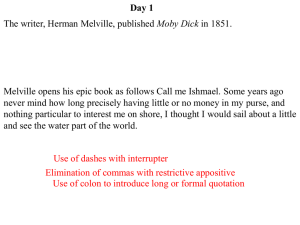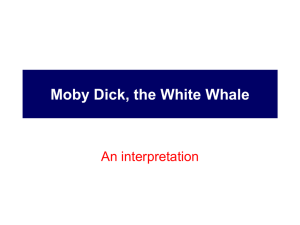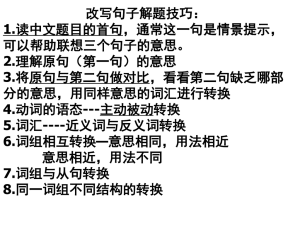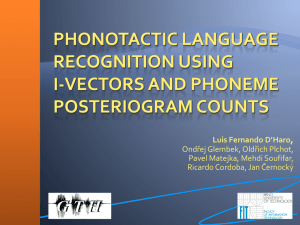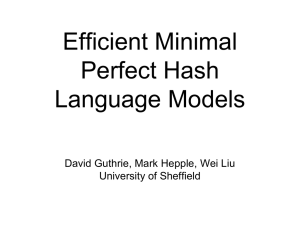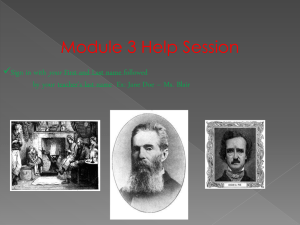n-gram Models over Sparse Data
advertisement
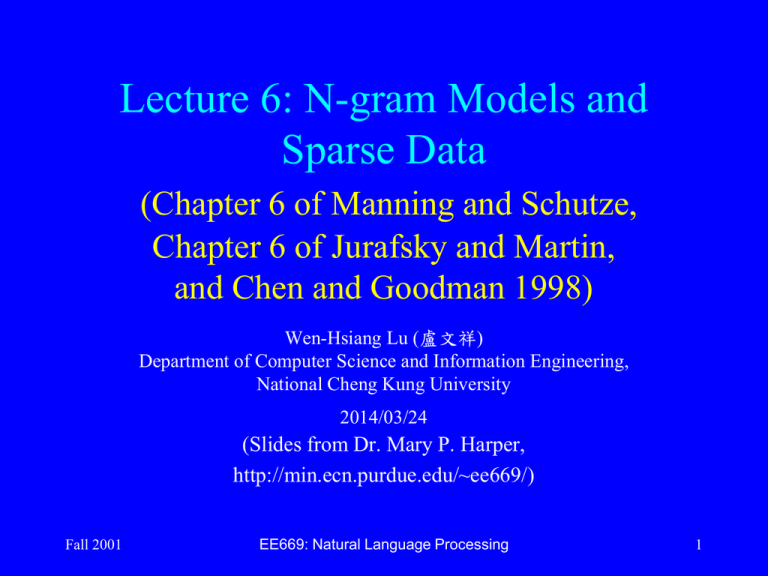
Lecture 6: N-gram Models and
Sparse Data
(Chapter 6 of Manning and Schutze,
Chapter 6 of Jurafsky and Martin,
and Chen and Goodman 1998)
Wen-Hsiang Lu (盧文祥)
Department of Computer Science and Information Engineering,
National Cheng Kung University
2014/03/24
(Slides from Dr. Mary P. Harper,
http://min.ecn.purdue.edu/~ee669/)
Fall 2001
EE669: Natural Language Processing
1
Overview
• Statistical inference consists of taking some data
(generated in accordance with some unknown
probability distribution) and then making some
inferences about its distribution.
• We will study the classic task of language
modeling as an example of statistical estimation.
Fall 2001
EE669: Natural Language Processing
2
“Shannon Game” and Language
Models
•
Claude E. Shannon. “Prediction and Entropy of Printed English”, Bell
System Technical Journal 30:50-64. 1951.
• Predict the next word, given the previous words
• Determine probability of different sequences by
examining training corpus
• Applications:
•
•
•
•
Fall 2001
OCR / Speech recognition – resolve ambiguity
Spelling correction
Machine translation
Author identification
EE669: Natural Language Processing
3
Speech and Noisy Channel Model
• In speech we can only decode the output to give the most
likely input.
^
W
W Noisy Channel A
Decode
p(A|W)
Pr( A | W ) Pr( W )
ˆ
W arg max Pr( W | A ) arg max
Pr( A )
W
W
arg max Pr( A | W ) Pr( W )
W
n
Pr( W ) Pr( W
) Pr( W | W
)
1, n
i
1, i 1
i 1
Fall 2001
EE669: Natural Language Processing
4
Statistical Estimators
• Example:
Corpus: five Jane Austen novels
N = 617,091 words, V = 14,585 unique words
Task: predict the next word of the trigram “inferior to ___”
from test data, Persuasion: “[In person, she was] inferior to
both [sisters.]”
• Given the observed training data …
• How do you develop a model (probability distribution)
to predict future events?
Fall 2001
EE669: Natural Language Processing
5
The Perfect Language Model
•
•
•
•
Sequence of word forms
Notation: W = (w1,w2,w3,...,wn)
The big (modeling) question is what is p(W)?
Well, we know (chain rule):
p(W) = p(w1,w2,w3,...,wn) = p(w1)p(w2|w1)p(w3|w1,w2)...
p(wn|w1,w2,...,wn-1)
• Not practical (even short for W too many parameters)
Fall 2001
EE669: Natural Language Processing
6
Markov Chain
• Unlimited memory:
– for wi, we know all its predecessors w1,w2,w3,...,wi-1
• Limited memory:
– we disregard predecessors that are “too old”
– remember only k previous words: wi-k,wi-k+1,...,wi-1
– called “kth order Markov approximation”
• Stationary character (no change over time):
p(W) @ Pi=1..n p(wi|wi-k,wi-k+1,...,wi-1), n = |W|
Fall 2001
EE669: Natural Language Processing
7
N-gram Language Models
• (n-1)th order Markov approximation n-gram LM:
p(W) Pi=1..n p(wi|wi-n+1,wi-n+2,...,wi-1)
• In particular (assume vocabulary |V| = 20k):
0-gram LM: uniform model
1-gram LM: unigram model
2-gram LM: bigram model
3-gram LM: trigram mode
4-gram LM: tetragram model
Fall 2001
p(w) = 1/|V|
p(w)
p(wi|wi-1)
p(wi|wi-2,wi-1)
p(wi| wi-3,wi-2,wi-1)
EE669: Natural Language Processing
1 parameter
2´104 parameters
4´108 parameters
8´1012 parameters
1.6´1017 parameters
8
Reliability vs. Discrimination
“large green ___________”
tree? mountain? frog? car?
“swallowed the large green ________”
pill? tidbit?
• larger n: more information about the context of
the specific instance (greater discrimination)
• smaller n: more instances in training data, better
statistical estimates (more reliability)
Fall 2001
EE669: Natural Language Processing
9
LM Observations
• How large n?
– zero is enough (theoretically)
– but anyway: as much as possible (as close to “perfect” model
as possible)
– empirically: 3
• parameter estimation? (reliability, data availability, storage space,
...)
• 4 is too much: |V|=60k 1.296´1019 parameters
• but: 6-7 would be almost ideal
• Reliability decreases with increase in detail (need compromise)
• For now, word forms only (no “linguistic” processing)
Fall 2001
EE669: Natural Language Processing
10
Parameter Estimation
• Parameter: numerical value needed to compute p(w|h)
• Data preparation:
•
•
•
•
get rid of formatting etc. (“text cleaning”)
define words (include punctuation)
define sentence boundaries (insert “words” <s> and </s>)
letter case: keep, discard, or be smart:
– name recognition
– number type identification
• numbers: keep, replace by <num>
Fall 2001
EE669: Natural Language Processing
11
Maximum Likelihood Estimate
• MLE: Relative Frequency...
– ...best predicts the data at hand (the “training data”)
– See (Ney et al. 1997) for a proof that the relative frequency really
is the maximum likelihood estimate. (p225)
• Trigrams from Training Data T:
– count sequences of three words in T: C3(wi-2,wi-1,wi)
– count sequences of two words in T: C2(wi-2,wi-1):
• Can use C2(y,z) = Sw C3(y,z,w)
PMLE(wi-2,wi-1,wi) = C3(wi-2,wi-1,wi) / N
PMLE(wi|wi-2,wi-1) = C3(wi-2,wi-1,wi) / C2(wi-2,wi-1)
Fall 2001
EE669: Natural Language Processing
12
Character Language Model
• Use individual characters instead of words:
p(W) df Pi=1..n p(ci|ci-n+1,ci-n+2,...,ci-1)
• Might consider 4-grams, 5-grams or even more
• Good for cross-language comparisons
• Transform cross-entropy between letter- and
word-based models:
HS(pc) = HS(pw) / avg. # of characters/word in S
Fall 2001
EE669: Natural Language Processing
13
LM: an Example
• Training data:
<s0> <s> He can buy you the can of soda </s>
– Unigram: (8 words in vocabulary)
p1(He) = p1(buy) = p1(you) = p1(the) = p1(of) = p1(soda) = .125 p1(can) = .25
– Bigram:
p2(He|<s>) = 1, p2(can|He) = 1, p2(buy|can) = .5, p2(of|can) = .5,
p2(you |buy) = 1,...
– Trigram:
p3(He|<s0>,<s>) = 1, p3(can|<s>,He) = 1, p3(buy|He,can) = 1, p3(of|the,can)
= 1, ..., p3(</s>|of,soda) = 1.
– Entropy: H(p1) = 2.75, H(p2) = 1, H(p3) = 0
Fall 2001
EE669: Natural Language Processing
14
LM: an Example (The Problem)
• Cross-entropy:
• S = <s0> <s> It was the greatest buy of all </s>
• Even HS(p1) fails (= HS(p2) = HS(p3) = ), because:
– all unigrams but p1(the), p1(buy), and p1(of) are 0.
– all bigram probabilities are 0.
– all trigram probabilities are 0.
• Need to make all “theoretically possible”
probabilities non-zero.
Fall 2001
EE669: Natural Language Processing
15
LM: Another Example
• Training data S: |V| =11 (not counting <s> and </s>)
– <s> John read Moby Dick </s>
– <s> Mary read a different book </s>
– <s> She read a book by Cher </s>
• Bigram estimates:
– P(She | <s>) = C(<s> She)/ Sw C(<s> w) = 1/3
– P(read | She) = C(She read)/ Sw C(She w) = 1
– P (Moby | read) = C(read Moby)/ Sw C(read w) = 1/3
– P (Dick | Moby) = C(Moby Dick)/ Sw C(Moby w) = 1
– P(</s> | Dick) = C(Dick </s> )/ Sw C(Dick w) = 1
• p(She read Moby Dick) =
p(She | <s>) p(read | She) p(Moby | read) p(Dick | Moby)
p(</s> | Dick) = 1/3 1 1/3 1 1 = 1/9
Fall 2001
EE669: Natural Language Processing
16
Training Corpus Instances:
“inferior to___”
Fall 2001
EE669: Natural Language Processing
17
Actual Probability Distribution
Fall 2001
EE669: Natural Language Processing
18
Maximum Likelihood Estimate
Fall 2001
EE669: Natural Language Processing
19
Comparison
Fall 2001
EE669: Natural Language Processing
20
The Zero Problem
• “Raw” n-gram language model estimate:
– necessarily, there will be some zeros
• Often trigram model 2.16´1014 parameters, data ~ 109 words
– which are true zeros?
• optimal situation: even the least frequent trigram would be seen several
times, in order to distinguish its probability vs. other trigrams
• optimal situation cannot happen, unfortunately
– question: how much data would we need?
• Different kinds of zeros: p(w|h) = 0, p(w) = 0
Fall 2001
EE669: Natural Language Processing
21
Why do we need non-zero
probabilities?
• Avoid infinite Cross Entropy:
H ( p ) p ( x ) log p ( x )
p ( x ) log
– happens when an event is found in the test data
which has not been seen in training data
• Make the system more robust
– low count estimates:
• they typically happen for “detailed” but relatively rare
appearances
– high count estimates: reliable but less “detailed”
Fall 2001
EE669: Natural Language Processing
22
1
p( x)
Eliminating the Zero Probabilities:
Smoothing
• Get new p’(w) (same W): almost p(w) except for
eliminating zeros
• Discount w for (some) p(w) > 0: new p’(w) < p(w)
Swdiscounted (p(w) - p’(w)) = D
• Distribute D to all w; p(w) = 0: new p’(w) > p(w)
– possibly also to other w with low p(w)
• For some w (possibly): p’(w) = p(w)
• Make sure SwWp’(w) = 1
• There are many ways of smoothing
Fall 2001
EE669: Natural Language Processing
23
Smoothing: an Example
Fall 2001
EE669: Natural Language Processing
24
Laplace’s Law:
Smoothing by Adding 1
• Laplace’s Law:
– PLAP(w1,..,wn)= (C(w1,..,wn)+1) / (N+B)
• C(w1,..,wn) is the frequency of n-gram w1,..,wn,
• N is the number of training instances,
• B is the number of bins training instances are divided into
(vocabulary size)
– Problem if B > C(W) (can be the case; even >> C(W))
– PLAP(w | h) = (C(h,w) + 1) / (C(h) + B)
• The idea is to give a little bit of the probability space to
unseen events.
Fall 2001
EE669: Natural Language Processing
25
Add 1 Smoothing Example
• pMLE(Cher read Moby Dick) =
p(Cher | <s>) p(read | Cher) p(Moby | read) p(Dick | Moby)
p(</s> | Dick) = 0 0 1/3 1 1 = 0
– p(Cher | <s>) = (1 + C(<s> Cher))/(11 + C(<s>))
= (1 + 0) / (11 + 3) = 1/14 = .0714
– p(read | Cher) = (1 + C(Cher read))/(11 + C(Cher))
= (1 + 0) / (11 + 1) = 1/12 = .0833
– p(Moby | read) = (1 + C(read Moby))/(11 + C(read))
= (1 + 1) / (11 + 3) = 2/14 = .1429
– P(Dick | Moby) = (1 + C(Moby Dick))/(11 + C(Moby))
= (1 + 1) / (11 + 1) = 2/12 = .1667
– P(</s> | Dick) = (1 + C(Dick </s>))/(11 + C<s>)
= (1 + 1) / (11 + 3) = 2/14 = .1429
• p’(Cher read Moby Dick) =
p(Cher | <s>) p(read | Cher) p(Moby | read) p(Dick | Moby)
p(</s> | Dick) = 1/14 1/12 2/14 2/12 2/14 = 2.02e-5
Fall 2001
EE669: Natural Language Processing
26
Laplace’s Law
(original)
Fall 2001
EE669: Natural Language Processing
27
Laplace’s Law
(adding one)
Fall 2001
EE669: Natural Language Processing
28
Laplace’s Law
Fall 2001
EE669: Natural Language Processing
29
Objections to Laplace’s Law
• For NLP applications that are very sparse,
Laplace’s Law actually gives far too much of the
probability space to unseen events.
• Worse at predicting the actual probabilities of
bigrams with zero counts than other methods.
• Count variances are actually greater than the
MLE.
Fall 2001
EE669: Natural Language Processing
30
Lidstone’s Law
PLid ( w1 w n )
C ( w1 w n ) λ
N Bλ
P = probability of specific n-gram
C = count of that n-gram in training data
N = total n-grams in training data
B = number of “bins” (possible n-grams)
= small positive number
M.L.E: = 0
LaPlace’s Law: = 1
Jeffreys-Perks Law: = ½
PLid(w | h) = (C(h,w) + ) / (C(h) + B )
Fall 2001
EE669: Natural Language Processing
31
Jeffreys-Perks Law
Fall 2001
EE669: Natural Language Processing
32
Objections to Lidstone’s Law
• Need an a priori way to determine .
• Predicts all unseen events to be equally likely.
• Gives probability estimates linear in the M.L.E.
frequency.
Fall 2001
EE669: Natural Language Processing
33
Lidstone’s Law with =.5
• pMLE(Cher read Moby Dick) =
p(Cher | <s>) p(read | Cher) p(Moby | read) p(Dick | Moby)
p(</s> | Dick) = 0 0 1/3 1 1 = 0
– p(Cher | <s>) = (.5 + C(<s> Cher))/(.5* 11 + C(<s>)) = (.5 + 0) /
(.5*11 + 3) = .5/8.5 =.0588
– p(read | Cher) = (.5 + C(Cher read))/(.5* 11 + C(Cher)) = (.5 + 0) /
(.5* 11 + 1) = .5/6.5 = .0769
– p(Moby | read) = (.5 + C(read Moby))/(.5* 11 + C(read)) = (.5 + 1)
/ (.5* 11 + 3) = 1.5/8.5 = .1765
– P(Dick | Moby) = (.5 + C(Moby Dick))/(.5* 11 + C(Moby)) = (.5 +
1) / (.5* 11 + 1) = 1.5/6.5 = .2308
– P(</s> | Dick) = (.5 + C(Dick </s>))/(.5* 11 + C<s>) = (.5 + 1) /
(.5* 11 + 3) = 1.5/8.5 = .1765
• p’(Cher read Moby Dick) =
p(Cher | <s>) p(read | Cher) p(Moby | read) p(Dick | Moby)
p(</s> | Dick) = .5/8.5 .5/6.5 1.5/8.5 1.5/6.5 1.5/8.5 =
3.25e-5
Fall 2001
EE669: Natural Language Processing
34
Held-Out Estimator
• How much of the probability distribution should
be reserved to allow for previously unseen events?
• Can validate choice by holding out part of the
training data.
• How often do events seen (or not seen) in training
data occur in validation data?
• Held out estimator by Jelinek and Mercer (1985)
Fall 2001
EE669: Natural Language Processing
35
Held Out Estimator
• For each n-gram, w1,..,wn , compute C1(w1,..,wn)
and C2(w1,..,wn), the frequencies of w1,..,wn in
training and held out data, respectively.
– Let Nr be the number of n-grams with frequency r in
the training text.
– Let Tr be the total number of times that all n-grams that
appeared r times in the training text appeared in the
held out data, i.e.,
• Then the average frequency of the frequency r
n-grams is Tr/Nr
• An estimate for the probability of one of these
n-gram is: Pho(w1,..,wn)= (Tr/Nr )/N
– where C(w1,..,wn) = r
Fall 2001
EE669: Natural Language Processing
36
Testing Models
• Divide data into training and testing sets.
• Training data: divide into normal training plus validation
(smoothing) sets: around 10% for validation (fewer
parameters typically)
• Testing data: distinguish between the “real” test set and a
development set.
– Use a development set prevent successive tweaking of the model to
fit the test data
– 5 – 10% for testing
– useful to test on multiple sets of test data in order to obtain the
variance of results.
– Are results (good or bad) just the result of chance? Use t-test
Fall 2001
EE669: Natural Language Processing
37
Cross-Validation
• Held out estimation is useful if there is a lot of
data available. If not, it may be better to use each
part of the data both as training data and held out
data.
– Deleted Estimation [Jelinek & Mercer, 1985]
– Leave-One-Out [Ney et al., 1997]
Fall 2001
EE669: Natural Language Processing
38
Deleted Estimation
• Use data for both training and validation
Divide training data into
2 parts
A
B
(1) Train on A, validate
on B
train
validate
Model 1
(2) Train on B, validate
on A
validate
train
Model 2
Combine two models
Fall 2001
Model 1
+
Model 2
EE669: Natural Language Processing
Final Model
39
Cross-Validation
Two estimates:
Pho
01
r
0
r
T
Pho
N N
T
10
r
1
r
N N
Nra = number of n-grams
occurring r times in a-th
part of training set
Trab = total number of those
found in b-th part
Combined estimate:
Pho
Fall 2001
T
01
r
T
10
r
N (N N )
0
r
1
r
(arithmetic mean)
EE669: Natural Language Processing
40
Good-Turing Estimation
• Intuition: re-estimate the amount of mass assigned to
n-grams with low (or zero) counts using the number of
n-grams with higher counts. For any n-gram that
occurs r times, we should assume that it occurs r*
times, where Nr is the number of n-grams occurring
precisely r times in the training data.
r ( r 1)
*
E ( N r 1)
E ( Nr)
• To convert the count to a probability, we normalize the
n-gram Wr with r counts as:
*
PGT (Wr ) r
Fall 2001
EE669: Natural Language Processing
N
41
Good-Turing Estimation
• Note that N is equal to the original number of
counts in the distribution.
N
N r* N
r
r 0
r 1
( r 1)
r 0
Nr
r
r 0
• Makes the assumption of a binomial distribution,
which works well for large amounts of data and a
large vocabulary despite the fact that words and
n-grams do not have that distribution.
Fall 2001
EE669: Natural Language Processing
42
Good-Turing Estimation
• Note that the estimate cannot be used if Nr= 0; hence, it is
necessary to smooth the Nr values.
• The estimate can be written as:
– If C(w1,..,wn) = r > 0, PGT(w1,..,wn) = r*/N where
r*=((r+1)S(r+1))/S(r) and S(r) is a smoothed estimate of the
expectation of Nr.
– If C(w1,..,wn) = 0, PGT(w1,..,wn) (N1/N0 ) /N
• In practice, counts with a frequency greater than five
are assumed reliable, as suggested by Katz.
• In practice, this method is not used by itself because it does
not use lower order information to estimate probabilities of
higher order n-grams.
Fall 2001
EE669: Natural Language Processing
43
Good-Turing Estimation
• N-grams with low counts are often treated as if they
had a count of 0.
• In practice r* is used only for small counts; counts
greater than k = 5 are assumed to be reliable: r* = r
if r> k; otherwise:
( r 1) N r 1
r
*
rN
( k 1) N k
N1
r
1
1
( k 1) N k
, for 1 r k
1
N1
Fall 2001
EE669: Natural Language Processing
44
Discounting Methods
• Absolute discounting: Decrease probability of
each observed n-gram by subtracting a small
constant when C(w1, w2, …, wn) = r:
{
( r ) / N , if r 0
p abs ( w 1, w 2 ,..., w n )
( B N 0 )
N 0N
, otherwise
• Linear discounting: Decrease probability of each
observed n-gram by multiplying by the same
proportion when C(w1, w2, …, wn) = r:
p lin ( w 1, w 2 ,..., w n )
Fall 2001
{
(1 ) r / N , if r 0
, otherwise
0
EE669: NaturalNLanguage
Processing
45
Combining Estimators: Overview
• If we have several models of how the history
predicts what comes next, then we might wish to
combine them in the hope of producing an even
better model.
• Some combination methods:
– Katz’s Back Off
– Simple Linear Interpolation
– General Linear Interpolation
Fall 2001
EE669: Natural Language Processing
46
Backoff
• Back off to lower order n-gram if we have no
evidence for the higher order form. Trigram
backoff:
P bo ( w i | w
i 1
i2
)
{
P (wi | w
i 1
i2
), if C ( w
i
i2
) 0
1 P ( w i | w i 1), if C ( w
i
i2
) 0 and C ( w
i
i 1
) 0
2 P ( w i ), otherwise
Fall 2001
EE669: Natural Language Processing
47
Katz’s Back Off Model
• If the n-gram of concern has appeared more than k
times, then an n-gram estimate is used but an amount
of the MLE estimate gets discounted (it is reserved
for unseen n-grams).
• If the n-gram occurred k times or less, then we will
use an estimate from a shorter n-gram (back-off
probability), normalized by the amount of probability
remaining and the amount of data covered by this
estimate.
• The process continues recursively.
Fall 2001
EE669: Natural Language Processing
48
Katz’s Back Off Model
• Katz used Good-Turing estimates when an n-gram
appeared k or fewer times.
(1 d w i i n 1 1)
P bo ( w i | w
Fall 2001
i 1
i n 1
)
{
C ( w i ni 1)
C ( w i i n 1 1)
, if C ( w i ni 1) k
w i i n 1 1 P bo ( w i |w i in1 2 ) , otherwise
EE669: Natural Language Processing
49
Problems with Backing-Off
• If bigram w1 w2 is common, but trigram w1 w2 w3
is unseen, it may be a meaningful gap, rather than
a gap due to chance and scarce data.
– i.e., a “grammatical null”
• In that case, it may be inappropriate to back-off to
lower-order probability.
Fall 2001
EE669: Natural Language Processing
50
Linear Interpolation
• One way of solving the sparseness in a trigram model is to
mix that model with bigram and unigram models that suffer
less from data sparseness.
• This can be done by linear interpolation (also called finite
mixture models).
Pli ( w i | w i 2 , w i 1 )
1 P1 ( w i ) 2 P2 ( w i | w i 1 ) 3 P3 ( w i | w i 2 , w i 1 )
Fall 2001
EE669: Natural Language Processing
51
Simple Interpolated Smoothing
• Add information from less detailed distributions using
=(0,1,2,3):
p’(wi| wi-2 ,wi-1) = 3p3(wi| wi-2 ,wi-1) +2p2(wi| wi-1) + 1p1(wi) + 0 /|V|
• Normalize:
i > 0, Si=0..n i = 1 is sufficient (0 = 1 - Si=1..n i) (n=3)
• Estimation using MLE:
– fix the p3, p2, p1 and |V| parameters as estimated from the training data
– then find {i}that minimizes the cross entropy (maximizes probability of
data): -(1/|D|)Si=1..|D|log2(p’(wi|hi))
Fall 2001
EE669: Natural Language Processing
52
CMU Language Model Toolkit
• Smoothing (Katz Back-off Plus Discount Method)
Using discounting strategy: r* = r dr
Multiple discounting methods:
Good-Turing discounting:
( r 1) n r 1
dr
( k 1) n k 1
rn r
1
n1
( k 1) n k 1
n1
Linear discounting: dr = 1 – n1/R
Absolute discounting: dr = (r-b)/r
Witten-Bell discounting: dr(t) = R/(R+t)
Fall 2001
EE669: Natural Language Processing
53
Homework 5
• Please collect 100 web news, and then build a bigram and a trigram
language models, respectively. Please use at least three sentences
to test your language models with two smoothing techniques, i.e.,
adding one and Good-Turing Estimation. Also, make some
performance analysis to explain which model and smoothing
method is better.
• Due day: March 31, 2014
• Reference: slides 6, 7, 16, 25, 41, 44
Fall 2001
EE669: Natural Language Processing
54


